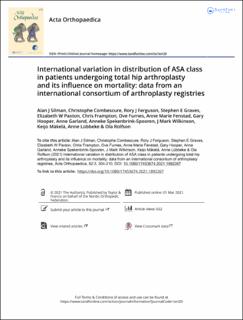| dc.contributor.author | Silman, Alan | |
| dc.contributor.author | Combescure, Christophe | |
| dc.contributor.author | Ferguson, Rory J | |
| dc.contributor.author | Graves, Stephen E. | |
| dc.contributor.author | Paxton, Elizabeth W | |
| dc.contributor.author | Frampton, Chris | |
| dc.contributor.author | Furnes, Ove Nord | |
| dc.contributor.author | Fenstad, Anne Marie | |
| dc.contributor.author | Hooper, Gary | |
| dc.contributor.author | Garland, Anne | |
| dc.contributor.author | Spekenbrink-Spooren, Anneke | |
| dc.contributor.author | Wilkinson, J. Mark | |
| dc.contributor.author | Mäkelä, Keijo | |
| dc.contributor.author | Lübbeke, Anne | |
| dc.contributor.author | Rolfson, Ola | |
| dc.date.accessioned | 2021-08-18T08:01:08Z | |
| dc.date.available | 2021-08-18T08:01:08Z | |
| dc.date.created | 2021-08-06T14:50:24Z | |
| dc.date.issued | 2021 | |
| dc.identifier.issn | 1745-3674 | |
| dc.identifier.uri | https://hdl.handle.net/11250/2769993 | |
| dc.description.abstract | Background and purpose — A challenge comparing outcomes from total hip arthroplasty between countries is variation in preoperative characteristics, particularly comorbidity. Therefore, we investigated between-country variation in comorbidity in patients based on ASA class distribution, and determined any variation of ASA class to mortality risk between countries.
Patients and methods — All arthroplasty registries collecting ASA class and mortality data in patients with elective primary THAs performed 2012–2016 were identified. Survival analyses of the influence of ASA class on 1-year mortality were performed by individual registries, followed by meta-analysis of aggregated data.
Results — 6 national registries and 1 US healthcare organization registry with 418,916 THAs were included. There was substantial variation in the proportion of ASA class III/IV, ranging from 14% in the Netherlands to 39% in Finland. Overall, 1-year mortality was 0.93% (95% CI 0.87–1.01) and increased from 0.2% in ASA class I to 8.9% in class IV. The association between ASA class and mortality measured by hazard ratios (HR) was strong in all registries even after adjustment for age and sex, which reduced them by half in all registries. Combined adjusted HRs were 2.0, 6.1, and 22 for ASA class II–IV vs. I, respectively. Associations were moderately heterogeneous across registries.
Interpretation — We observed large variation in ASA class distribution between registries, possibly explained by differences in background morbidity and/or international variation in access to surgery. The similar, strong mortality trends by ASA class between countries enhance the relevance of its use as an indicator of comorbidity in international registry studies. | en_US |
| dc.language.iso | eng | en_US |
| dc.publisher | Taylor and Francis | en_US |
| dc.rights | Navngivelse 4.0 Internasjonal | * |
| dc.rights.uri | http://creativecommons.org/licenses/by/4.0/deed.no | * |
| dc.title | International variation in distribution of ASA class in patients undergoing total hip arthroplasty and its influence on mortality: data from an international consortium of arthroplasty registries | en_US |
| dc.type | Journal article | en_US |
| dc.type | Peer reviewed | en_US |
| dc.description.version | publishedVersion | en_US |
| dc.rights.holder | Copyright 2021 The Author(s) | en_US |
| cristin.ispublished | true | |
| cristin.fulltext | original | |
| cristin.qualitycode | 1 | |
| dc.identifier.doi | 10.1080/17453674.2021.1892267 | |
| dc.identifier.cristin | 1924432 | |
| dc.source.journal | Acta Orthopaedica | en_US |
| dc.source.pagenumber | 304-310 | en_US |
| dc.identifier.citation | Acta Orthopaedica. 2021, 92 (3), 304-310. | en_US |
| dc.source.volume | 92 | en_US |
| dc.source.issue | 3 | en_US |

